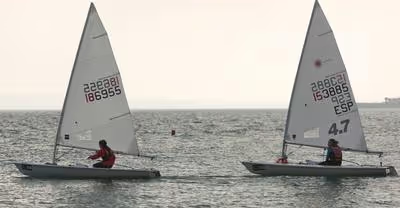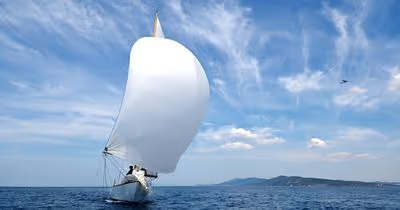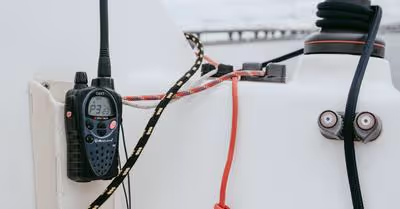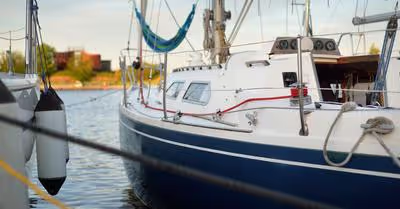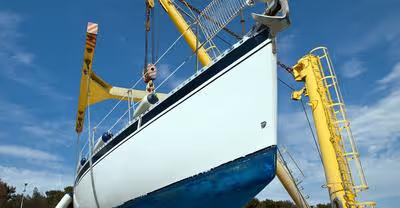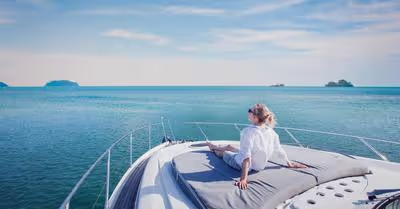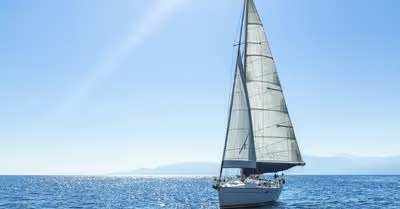Table of Contents
West Wight Potter 19
For nearly three decades, the West Wight Potter 19 has been a favorite compact cruiser sailboat. International Marine in California built it after being inspired by an original idea in the United Kingdom.
Over the years, various upgrades have been made, but the boat has maintained its original appearance and garnered a significant and devoted following.
The Potter 19 adds to West Wight Potter's reputation for its rugged build and simple handling. It is a trailerable sailboat with all the comforts you might want for relaxing weekend vacations on the ocean.
The West Wight Potter 19 has the same seaworthiness and control as its smaller sibling but with more sailing comforts and interior space. This fiberglass sailboat measures 19 feet in length. The hull has a large amount of good buoyancy, making the boat virtually unsinkable.
The Potter 19 is famous because it is a sturdy, tiny, and spacious boat. It has a high centerboard to keep the cockpit clean, and it is a simple and tolerant boat to sail because of its hard-chine hull. For shorter cruises, the cabin is large enough for a pair to camp comfortably.
The Potter 19 has even crossed the Atlantic and been carried back and forth, passing from California to Hawaii!
There are two berths that can accommodate four people. A cooler and a burner stove are also included in the cabin. You can have the boat modified to your needs based on your ideas.
The inside of the Potter 19 is well-designed. Even though sailing on a tiny sailboat is comparable to camping with the luxury of a walk-around area found on bigger cruising boats, the Potter 19 is more pleasant than most other boats of its size.
Catalina 22 Sport
In the United States, the Catalina 22 is among the most famous sailboats. A crew of Catalina 22 may be found at almost any marina regardless of wherever you go. The only option to get a Catalina 22, since they had stopped building them, was to purchase a used one. However, after decades of anticipation, the sailboat maker finally released the 22' Sport. It's nearly identical to the original 22, so you may enter a Catalina 22 group alongside the original boats.
The Catalina 22 Sport was launched in 2004 and is still in operation, preserving the original boat's size and weight. The 23.83 ft. sailboat has a foldable or swing keel which pulls only 1′8′′ when fully extended. As a result, the ramp launch is straightforward, and you may cruise practically anywhere without fear of going aground. A mast elevating mechanism can be installed on the Catalina 22 sport to make lifting and dropping the mast easier.
The boat's characteristics are a detachable lead keel, a four-person cabin with a forward door for ventilation, and a modest rig with a roller-furling jib. The wide cockpit can accommodate a large group of people and allows them to enjoy their voyage.
In a nutshell, the Catalina 22 Sport is a competent boat that delivers the price and quality that Catalina customers have grown to expect from Catalina's great sailboats over the past decades. Catalina, unlike many other sailboat manufacturers currently available on the boat marketplace, is still operational and continues to make components for the Catalina 22 sport.
Hunter 22
The Hunter 22 is a direct descendant of the Hunter 216, which was constructed by using competent thermoformed Luran-S plastic. The hull of the 22 is similar to that of the 216, with a spacious cockpit and wide transom; however, it is constructed of fiberglass with a substantial bottom and balsa-cored topsides. In addition, the deck, which really is similarly balsa-cored, has been tweaked, along with the rig that has grown by 40 sq. ft.
The 22.25 ft. sailboat has a hydraulically operated swinging ballast keel, just like its forerunner. A full mid-cockpit traveler, trekking grips and belts in the cockpit, a flexible bowsprit, and an unbalanced spinnaker are all essential components of the model. More amenities include a V-berth, a portable bathroom, and a rudimentary electrical system, all of which are included in the cruising kit.
The Hunter 22 is renowned for being sturdy and reliable. It's perfect for a day cruise or weekend getaway. The boat is still capable of traveling fast, along with being family-friendly. The rudder is arguably the most crucial difference between the previous 216 and this sailboat.
A VARA inboard lifting rudder moved up or down on the old boat. The construction was sturdy, but the steering responsiveness was poor. A traditional rudder turns on a hinge near the transom in the Hunter 22.
The Hunter 22 is more reactive, faster, and less difficult to sustain than its predecessors. It is sturdy and user-friendly when sailed cautiously, and it should make a wonderful starter boat for new families who are just getting into sailing. It will be a satisfying voyage for seasoned sailors as well.
Sage 15
The Sage 15 is a tiny sailboat with an abstract style and a good aesthetic. It's quite similar to its older sibling, the Sage 17, but with a detachable keel. The boat is vacuum-infused and manufactured with a blend of fiberglass mat, fabric, vinyl ester resins, and a balsa base, just like any race boat. Chemical glue and a set of through-bolts are used to fix the hull-and-deck junction. Sage Marine, located in Colorado, is owned by the people who make the superbly crafted Spyderco brand of knives, and the sailboats they make exhibit the same degree of precision.
In the same spirit, the boat is well prepared for day sailing or camping, with spacious cockpit chairs, extremely massive cabins below decks with lots of stowage below, and a sprinkling of wood trim. The Sage 15's sailing performance is as good as its quality of construction.
It's worth noting that the mast and its gear barely weigh 20 lbs., making it simple to lift up and down on your own. This is a big benefit when towing to/from your destination. This boat can accommodate two persons on the decks and in the cockpit. It's ideal for folks who love a solitary trip now and then or couples who occasionally want to spend a day on the lake.
Moore 24
The Moore 24, which was designed in the 1960s and first constructed in 1972, prepared the path for an entire era of lightweight displacement sailboats that would go on to establish California's place in sailboat racing history. The Moore 24 was developed by renowned sailor and surfer George Olson as the lightest way of creating a racing keelboat that could employ a Cal 20 rig.
The small speedsters rapidly proved their worth in the powerful summer winds and massive swells of Monterey Bay and the San Francisco area, riding through 50-foot IOR models in regional offshore races thanks to sturdy construction and unmatched speed.
The Moore 24 became a masterpiece in Northern California and along the United States West Coast during the past forty years. You'll frequently see over 30 one-design sailboats at a big race in Santa Cruz or the Pacific Northwest. The 24 appeal and extensive list of outstanding owners attest to the design's durability and resilience.
The Moore 24 is an example of minimalism. The boat will attract racers and cruisers alike. The rig is carefully set up and manufactured from the best components in the marketplace, and the hull's V-shape gives a pleasant, high-performance glide.
The distinctive cruising cabins on a Moore 24 are designed to handle both the racer and the cruiser. The remarkable performance will impress experienced sailors, but the ease with which a Moore 24 may be mastered will impress beginner sailors immensely.
Cape Dory 28
The Cape Dory 28 is a classic Carl Alberg model known for its spacious living area and well-rounded performance. With conventional style and substantial proportions of polished teak and brass, this roomy small cruiser has the design and ability of many bigger vessels.
The Cape Dory 28 has a full-length keel with a connected rudder, minimal freeboard, a very attractive sheer, and a conventional trunk compartment with good proportions. The balance of the deck is excellent. The foredeck is big enough for sail management and ground equipment, while the side decks are broad enough for safe transport, and the cockpit can fit four adults easily.
The mainsheet connects with the cockpit to avoid interfering with guests, and most 28s feature tiller handling that can be conveniently stored at anchor. A front V-berth is accompanied by a port head and a starboard storage locker on the inside. The galley is located ahead, with a compact alcohol stove and an icebox. For a vessel of its size, two opening deck ports and eight opening aluminum ports give ample ventilation. The Cape Dory 28 has appealing qualities for long-haul excursions, as well as the flexibility and speed required for tighter coastal regions. This 28-inch sailboat is perfect for saltwater cruising, but it's a little too big for tiny rivers and lakes.
Islander 24
The Islander 24 Bahama, commonly known as the Islander Bahama 24, is a trailerable boat developed and made by Joseph McGlasson in 1964. The 24 Bahama is a modification of the 1961 Islander 24, which was itself a fiberglass improvement of the Catalina Islander's hardwood hull. This 24-foot fiberglass boat has a tough construction and low maintenance requirements that are uncommon on vessels of this size.
The layout has been used by weekenders and cruise sailors equally for over forty years. The Islander 24 is a versatile cruise boat with comfortable two-person accommodation. A forward-facing sleeper, space for a bathroom, and benches for a sink, stove, or navigating are all included in the cabin.
The boat features a masthead loop rig, an elevated transom, a tiller-controlled keel-mounted rudder, and a permanent fin keel. It weighs 4,200 pounds and contains 1,600 pounds of lead ballast. The boat is easy to handle by one person, and the gear is simple enough just to store without too much difficulty.
The Islander 24 is a popular trailer sailer, with many owners opting to keep it in the water. This small sailboat is suited for cruising shorelines, while some mariners have undertaken longer excursions in it and have not been dissatisfied.
Catalina 16.5
Catalina has been a prominent sailboat company for decades, and their bigger boats are undoubtedly among the most popular sailboats seen at any harbor. Catalina sailboats are constructed of lightweight fiberglass and come with conventional, high-quality rigging. They're inexpensive to buy and easy to locate.
The Catalina 16.5 has a spacious cockpit and a huge front storage space, making it perfect for family vacations. Two keel configurations are available for the 16.5 sailboats. The aggressive sail plan of the Centerboard model is matched by the solid hull structure and fiberglass centerboard and rudder. Standard features include adjustable walking straps, tiller extensions, variable outhaul, and a sheet bag.
The Keel type is ideal for mooring or docking the boat for the majority of the year. A bilge sump with a molded-in seal is supplied. The casting lead high aspect keel is secured with stainless keel bolts. It is also important to know that the Catalina 16.5 was introduced in 1994 and remained in production until 2017. It weighs less than 500 pounds, making it simple to pull with almost any automobile, so don't fret about investing in a big truck.
This trailerable 16.33 ft. sailboat can seat up to four people and features a storage box in the front. The Catalina 16.5 could be the sailboat for you if you're looking for a vessel to sail across the clear waters.
Recent Articles



